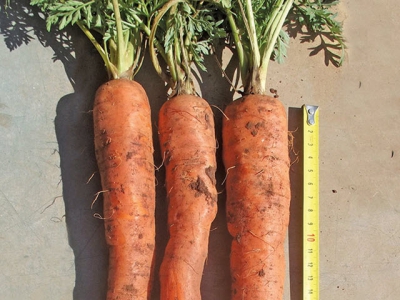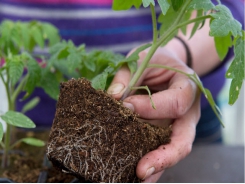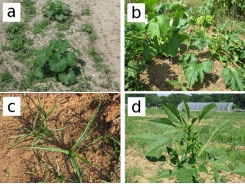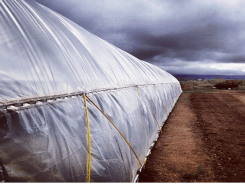Deeper roots, better carrots

Given the right conditions, a carrot’s extensive fine feeder roots can reach 3m into the soil. It’s important to know this, as it will change the way you treat both the soil and the crop.
Irrigation can influence the carrot’s length. Photo: Bill Kerr
When preparing the land, beware of concentrating only the carrot – the edible taproot that usually reaches a length of 20cm to 30cm. A deep root system sources water from far down and allows the plant to extract nutrients from deep in the soil profile.
This is especially important on lands where other vegetables or well-fertilised crops have been grown in the past. Some of the nutrients will have leached into the deeper layers, and carrots are able to make use of these, unlike crops with a shallow root system.
For this reason, most farmers who have carrots in a regular rotation with other vegetables can grow the crop without any fertiliser. However, as noted, development of a deep root system is not a given – you need to help things along by ensuring that the right conditions are present.
Irrigation: getting it right
The first consideration is whether the soil will permit roots to penetrate to deeper levels. This will not happen if you have a plough pan or a naturally hard or impervious layer soil.
If you detect such a layer when pushing a probe into moist soil, consider deep ripping.
Next, irrigate in a way that enables or encourages the roots to penetrate deeply. In dry weather, start
off with lighter, more frequent irrigations to get the seeds germinated well and make sure the water penetrates the soil below the reach of the taproot at this stage.
Irrigation can influence the carrot’s length.
As a rough guide, 1mm of water will penetrate 1cm of soil, although much will depend on the soil type and its organic and moisture content at the time of irrigation. After germination, gradually switch to fewer irrigations, but increase the amount of water used in each session.
You can also stress the carrots a little each time to encourage the roots to look for water. When I was farming carrots, I would do this on occasion by having the sprinklers working the whole day in one place on the land.
When stressed, the leaves will become a darker, duller colour and lose their lustre. They should never be allowed to be stressed to the point of wilting, though. Some years ago, a client bought a centre pivot and planted carrots.
I explained to him the principle of progressive stressing and deeper irrigation, but he was obviously sceptical about it as he did not follow my advice.
When the land was ready for harvesting, he complained to me that the carrots were too short and blamed the variety.
Knowing that he had had heavy rain a few weeks before and realising that, due to the wind, the edge of the pivot was often short of water, I dug up a few carrots here. They were the correct length, unlike those in the middle of the land.
The farmer had applied frequent, light irrigations, but because the edge was always drier, this forced the roots deeper, enabling the plants in this area to retrieve moisture deeper down from rain that had soaked in a few weeks previously.
By contrast, the carrots in the well-irrigated section had no need to look for deeper water – the taproots were satisfied too soon, as it were.
It is important, however, to always know the moisture status of the soil when growing carrots. In winter, when it’s dry, I often come across farmers who apply a weekly irrigation irrespective of the depth of penetration.
Deeper roots can extract all the available moisture, leaving the soil dry and hard further down. If irrigation is shallow and light, it will be insufficient to soak deeply and compensate for this.
As a result, the tips of the carrots pushing against the dry soil can become pinched, restricting the growth of the vegetable.
Related news
Tools

Phối trộn thức ăn chăn nuôi

Pha dung dịch thủy canh

Định mức cho tôm ăn

Phối trộn phân bón NPK

Xác định tỷ lệ tôm sống

Chuyển đổi đơn vị phân bón

Xác định công suất sục khí

Chuyển đổi đơn vị tôm

Tính diện tích nhà kính

Tính thể tích ao




 Eelworms love carrots
Eelworms love carrots  The 4 Best Ways to Cool a Greenhouse
The 4 Best Ways to Cool a Greenhouse